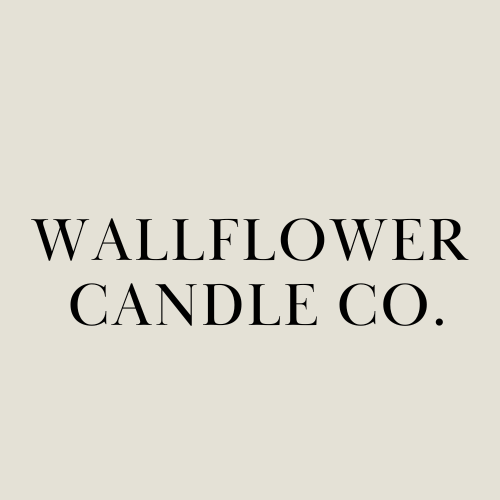
If you’re a candle lover, you’ve probably seen a wide variety of candles made with different materials and containers. Candle makers are able to choose from several different waxes, wicks, fragrances, and containers. So how do you choose what to buy?
Decide for yourself and your family what you want to bring into your home! Make sure you’re well informed on the candles you’re buying, and what they’re made with.
At Wallflower Candle Co., our candles are made using:
A paraffin/soy wax blend
One of the questions I’m asked most often is what wax I used for my candles and melts. The paraffin/soy (also known as parasoy) wax blend that I use quickly became my favorite when I was first creating test candles. It offers the stronger hot throw of paraffin, but burns slower due to the soy. It pours beautifully, and burns beautifully. And just as important – it’s safe to burn.
The paraffin vs. soy debate about which is better or safer for burning has been going on for a while. The truth is, they’re both equally safe to burn. Which type of wax you prefer is just that – a preference! They both have good qualities to them, which is why I use a blend. If you’re curious to learn more about candle composition and safety, a great resource to check is the National Candle Association webpage. But for now, here’s a brief look at what the National Candle Association has to say about different waxes:
“All types of quality candle waxes have been shown to burn cleanly, safely, and in the same manner. While you may have heard that certain candle waxes burn ‘better’ than other types, this is nothing but a common rumor. An international study was conducted on soy wax, paraffin wax, beeswax, and other commonly used waxes. Findings showed that all well-made candles exhibit the same clean burning behavior, and pose no risk to human healthy or indoor air quality.”
Cotton wicks
The wicks in our candles are a flat braided cotton wick with paper threads woven in. Because of the reinforced construction of them, the wick ensures a consistent burn – especially with softer waxes, like soy. Cotton wicks produce a bright traditional flame, as opposed to wood wicks, which provide a smoldering, crackling burn. While there’s nothing wrong with the crackle of a wood wick, we prefer the traditional look and flame we get with cotton.
Phthalate-free fragrance oils
Phthalates are a family of synthetic chemicals that have been used widely for over 50 years. Their purpose in fragrance oils has been to retain scent. But continued research into these chemicals has shown that they can act as endocrine disruptors, which can adversely affect different hormones. It has been fairly common to include phthalates in fragrance oils used for things like candles – but candle makers do have the choice now to purchase fragrances t that don’t include phthalates. At Wallflower Candle Co., we’ve made the choice to use phthalate-free fragrance oils in our products.
High quality, heat resistant vessels
We of course want candles to look good, not just smell good. But we also want the candle vessels to be safe, and capable of withstanding the heat. Our candle vessels are beautiful and safe – made with thick, heat-resistant glass and metal (for our copper tins). The choice of vessel is really important – not all are appropriate for candle making! Not just any pretty vessel can be used to make a candle, and they need to be tested for safety.
Minimalist packaging
We like to keep things simple. Our labels and packaging are clean and minimal – we like to let the quality of our products speak for itself. The vessels we use are beautiful, and we don’t want to take away from their decorative element. And to quote Don Draper from Madmen, the best marketing and design technique is to “make it simple, but significant.”
What you won’t find in our candles:
Non-wax embeds
There are some candles out there that have materials embedded for aesthetic, like dried flowers or herbs, coffee beans, or crystals. I have nothing against this personally. It doesn’t fit my style or the branding of my candles, but I also am not totally convinced of the safety in adding potentially flammable materials to a candle.
Dye or mica
These are additional elements that are used to make candles look aesthetically pleasing. Dye is obviously used to color wax, while mica is used to make a wax look sparkly. There’s nothing inherently bad about either. Mica can clog wicks if not used properly, which can affect the burn. I personally prefer white wax over colored waxes, and honestly for me – the less additives in anything, the better.
Plenty of thought and research has gone into our candle line, and we’re grateful that you trust us and our products enough to bring them into your home with your families and pets!
